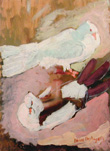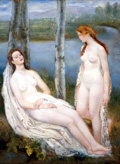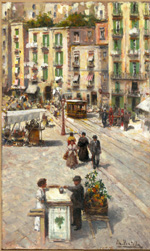Deiva De Angelis (1885-1925), a "fauve" in Rome
(Deiva De Angelis
1885-1925
una "fauve" a Roma)
in collaboration with Associazione Amici di Villa Strohl-Fern
edited by Lela Djokic, Donatella Trombadori
with the collaboration of Daina Maja Titonel
|

|
February 3 - March 5, 2005
catalogue edited by Lela Djokic, Daina Maja Titonel,
texts by Duccio Trombadori, Francesca Romana Morelli, Lucia Fusco.
|
|
reviews on web:
Exibart - Deiva De Angelis
.:. Artemania - Deiva De Angelis: la pittrice dei misteri
.:. art49 - Deiva De Angelis
.:. ARTFAQ - Deiva De Angelis
.:. RomaOne - Deiva De Angelis
|
Thursday February 3rd, 2005 at 5pm, the Nuova Galleria Campo dei Fiori presents the first-ever monographic
exhibition dedicated to an umbro-roman paintress by the name of Deiva De Angelis (Gubbio 1885 - Rome, February
24th, 1925).
The exhibition was organized with the support of the Associazione Amici di Villa Strohl-Fern in rememberance of
the 120th anniversary of birth and the 80th year of death of the artist. The curators of the exhibit are Lela Djokic
and Donatella Trombadori with the colaboration of Daina Maja Titonel.
For the occasion, a catalogue has been published, edited by Lela Djokic and Maja Titonel with words by Duccio Trombadori, Francesca Romana Morelli and Lucia Fusco.
The exhibit brings together more than twenty oil paintings, the majority of which arrive from the historic private collections, including the two paintings Tolette (1915) and Paesaggio urbano (1918), which belonged to the
historic art historian Roberto Longhi, and that are now catalogued in Florence in the Fondazione di Studi di
Storia dell'Arte. Aside from these masterpieces, the aim is to rediscover less-noted works and in many cases
unknown ones.
The unique character of the paintress, her brief and odd life, full of uncertainty, including her anagraphic data,
is alone a literary work. Illegitimate child, she is born in Gubbio, in approximately the year 1885 (anagraphic data
is often missing in this paintresses life). Deiva Terradura (her maiden name) arrives in Rome in the first
years of the 20th century. She begins to sell flowers at Piazza di Spagna, which was the square where the
unemployed frequently searched for work. Soon after, she begins to work as a model in the studios on Via Margutta.
The English painter William Walcot (Odessa 1874 - London 1943) discover the hidden artistic talent behind the
beutiful model. Together, they travel to Paris and London, where the young paintress witnesses the lastest european
tendencies. Still very young, she marries the Pugliese lawyer De Angelis and will always use this name when
signing her paintings.
Between 1914 and 1918 she works in a studio at Villa Strohl-Fern together with Cipriano Efisio Oppo, with whom
in those years she is emotionally involved. In rome, she participates in the three editions of the Secessione in
which other works such as the Fauve and Impressionist movements are present. In 1918, she exhibits together with Armando Spadini at the
Casina Valadier and in 1920 she presents her paintings in a personal exhibit at the Casa d'Arte Bragaglia, one of the main futurist galleries. Finally, she also participates in the three editions of
the Biennali romane in 1921, 1923 and 1925.
She dies in Rome at the young age of forty on the 24th of February 1925, on Via Angelo Brunetti, near Piazza del
Popolo.
|
Unveiled bodies 1900-1950, the nudes in Rome from Sartorio to Pirandello
(Corpi svelati
1900-1950
Il nudo a Roma da Sartorio a Pirandello)
|
edited by Lela Djokic, Flavia Matitti
with the collaboration of Daina Maja Titonel
|

|
May 5 - June 25, 2005
catalogue edited by Flavia Matitti.
|
|
reviews on web:
Exibart - Corpi svelati
|
The exhibition aims to offer a synthesis of different ways of perceiving and represent the nude through twenty
different art pieces, both paintings and sculptures. The setting is Rome, during the first half of the
20th Century, from the time of the Belle Epoque to the years of Neorealism,
although the emphasis will be on the beginning of the century.
The exhibition brings together some important historical pieces of art, among which it worth highlighting two fret panels, dated 1903, created by Giulio Aristide Sartorio to decorate the Sala del Lazio at the Biennale di Venezia and the bronze sculpture Bagnante, by Alfredo Biagini, which used to beautify the Sala Etrusca of the Quirinetta (Rome), the worldly place planned by Marcello Piacentini and inaugurated in 1927.
Another peculiarity of the exhibition is that it will present the paintings of two well known sculptors: Ercole Drei with its Conchiglia, painting exhibited in 1934 during the IV Sindacale Romana, and Arturo Dazzi with Estate, the large and substantial painting presented in 1935, during the II Quadriennale, and never exhibited again.
In addition, an oil painting of Adolfo De Carolis and the bronze sculptures of Amleto Cataldi and Ivan
Mestrovic document the symbolist and liberty tastes, whereas the Roman Divisionism pulsates in the
female nudes of Arturo Noci, Camillo Innocenti, Aleardo Terzi and Ferruccio Ferrazzi.
The return to order, after World War I, is represented by a monumental drawing of the "Neoclassical" painter
Francesco Trombadori. The nudes painted by Felice Carena and Giovanni Guerrini are inspired
by the atmosphere of the 20th century, whereas Armando Spadini stands independently with a sketch for the Bagnante.
Alberto Ziveri's oil on canvas and Antonietta Raphaël's terracotta prove the maturation of a new cultural
climate in the light of expressionism and realism. Two paintings by Fausto Pirandello both ideally and
chronologically conclude the path of the exhibition.
|
Le vie dell'Ottocento 1815-1915, 40 pieces for a collection
(Le vie dell'Ottocento
1815-1915
40 opere per una collezione)
|
edited by Lela Djokic and Daina Maja Titonel
|

|
November 24, 2005 - January 22, 2006
|
reviews on web:
Exibart - Le vie dell'Ottocento
|
La prima mostra della stagione autunnale della Nuova Galleria Campo dei Fiori è dedicata
al collezionismo dell’Ottocento e si inaugura giovedì 24 novembre 2005.
Presenta una selezione
di quaranta opere fra oli, tempere, acquerelli, pastelli, terrecotte, bronzi e un bassorilievo in legno.
Nella quale un collezionismo attento potrà scegliere fra vedute, paesaggi, ritratti, scene di genere
e opere in scultura.
Tra i lavori esposti spicca la grande tela dipinta nel 1879 da Hermann
Corrodi (1844-1905), Strada di paese con il Vesuvio sullo sfondo.
Di grandi dimensioni è il capolavoro di Camillo Innocenti (1871-1961), Al Divino Amore,
esposto recentemente all’Accademia di San Luca nella mostra La Campagna Romana de 'I XXV'.
Il dipinto fu presentato già nel 1897 alla Prima Esposizione Artistica Italiana in Pietroburgo.
Si espone per la prima volta in galleria una suggestiva Caccia alla volpe di Giovanni Battista
Filosa (1850-1935), dipinta durante il soggiorno parigino dall’artista napoletano, fra il 1873 e il
1884 quando lavorava per il noto mercante Goupil ed esponeva annualmente ai Salons.
Tra le vedute si segnalano due lavori inediti di Attilio Pratella (1856-1949) con scorci di vita
di strada nella Napoli di inizio Novecento. Mentre è ancora Napoli, vista da Mergellina, a far da protagonista
nell’olio di Salvatore Candido; assieme a una classica veduta del golfo dipinta finemente da
Teodoro Duclére (1815-1869). Ad entrambe si aggiunge una veduta di Pompei di Edoardo
Forti.
Di Fausto Pratella (1888-1948) si espone una veduta del Porto di Chioggia sotto
la neve. Il Castello Aragonese compare infine nella veduta di Ischia di Romolo Leone.
A Venezia sono dedicate invece le due tavolette, di Pietro Fragiacomo (1856-1922) e Stefano
Novo (1862-1927c.). Del 1911 è il Boulevard di Parigi del napoletano Francesco Cangiullo
(1884-1977), dipinto prima dell’adesione al Futurismo.
Sempre nell’ambito dei paesaggi, troviamo la Toscana nelle tavole di Carlo Domenici
(1898-1981), Buttero a cavallo, e nella Marina di Gino Romiti (1881-1967).
Fra le figure ecco una Carmen ritratta su fondo oro da Antonio Mancini (1852-1929)
dove la preziosità della tela ben si sposa alla cornice disegnata da Francesco Paolo Michetti.
E poi due ritratti eseguiti da Edoardo Gioja (1862-1937) a Londra, dove l’artista
si trasferisce divenendo ritrattista ufficiale della buona società inglese. Ancora di Edoardo Gioja
è un pannello liberty scolpito in legno: La ridda dei pesci, che faceva parte della camera
da pranzo del villino Manzi di Roma.
Di Gustavo Simoni (1845-1926) sono esposti due acquerelli di cui uno di soggetto orientalista,
Suonatori arabi. Di stampo orientalista sono anche i vari acquerelli di Johann Jakob Frey
(1813-1865).
Del russo Alessio Issupoff (1889-1957) è la tavoletta Contadini russi.
Una scena domestica compare invece nell’olio di Cafiero Filippelli (1889-1973).
Segue La lezione, una deliziosa scena con quattro bambini mentre studiano, opera della poco
nota pittrice e miniaturista marchigiana Imelde Santini (1857-1947).
Chiude la rassegna l’unica natura morta presente in mostra di Giovanni Bartolena (1866-1942).
|
|

